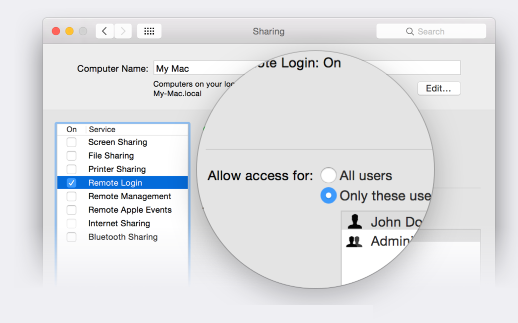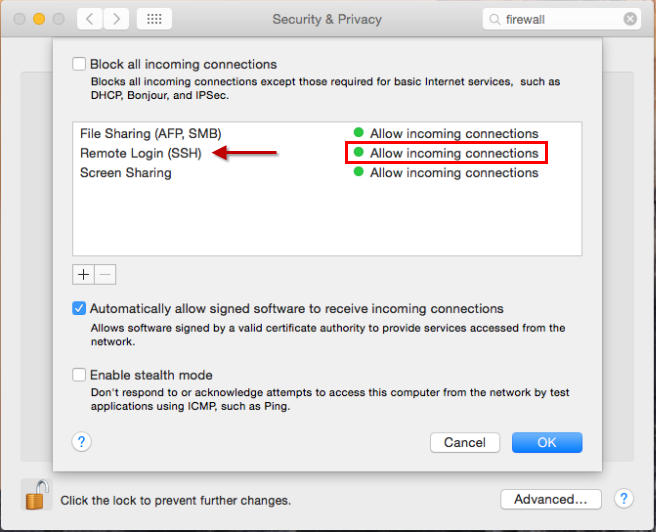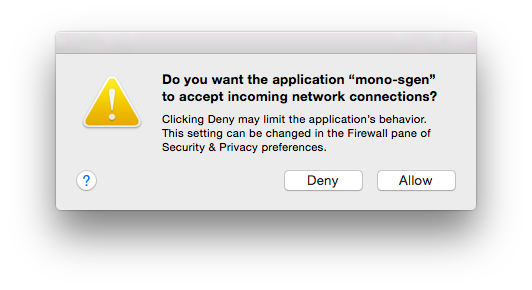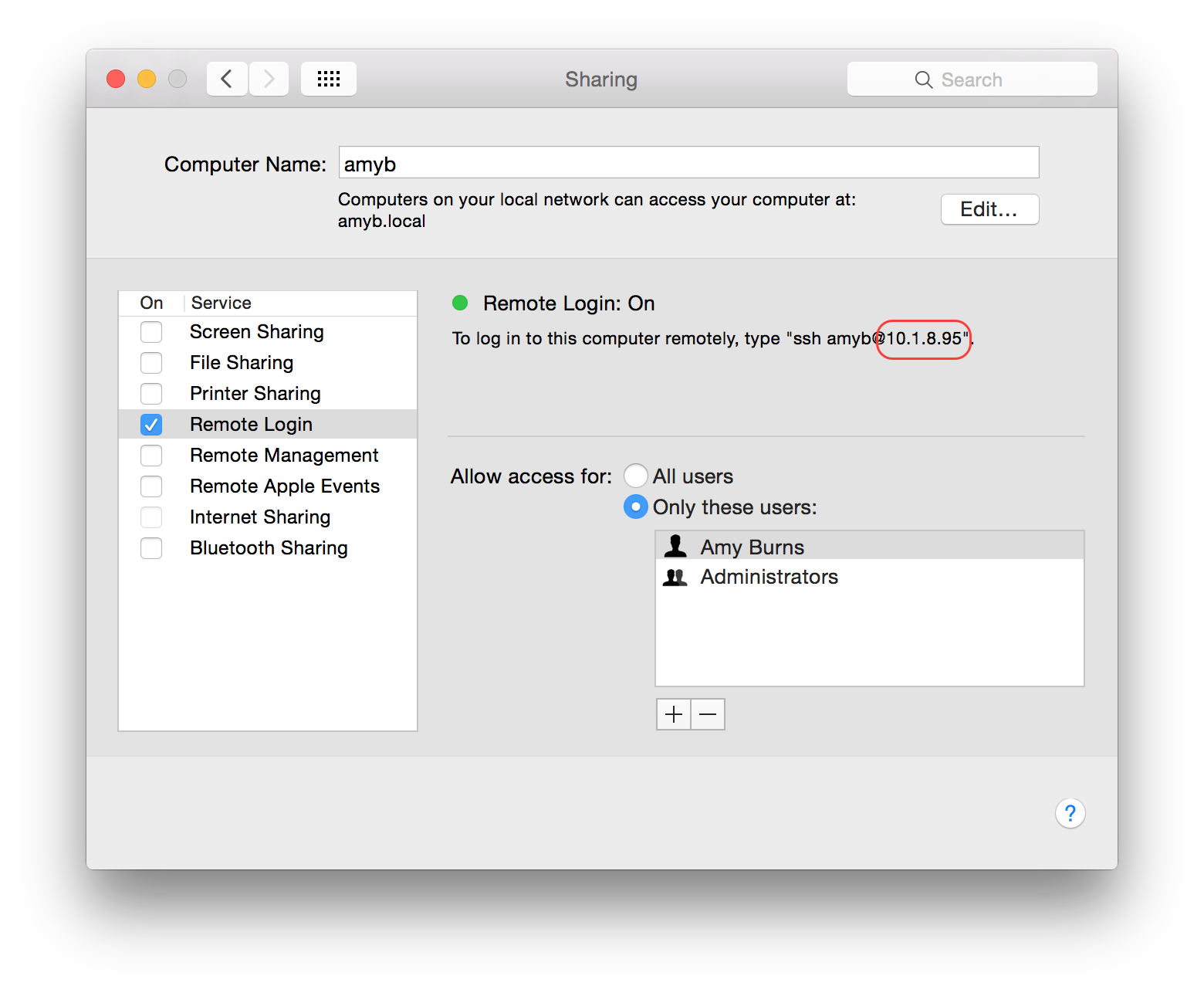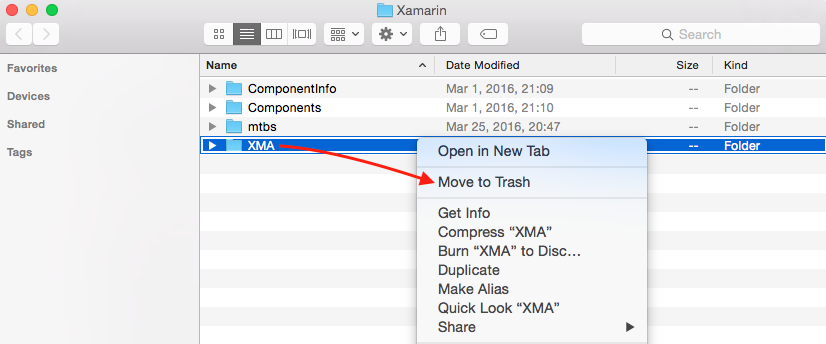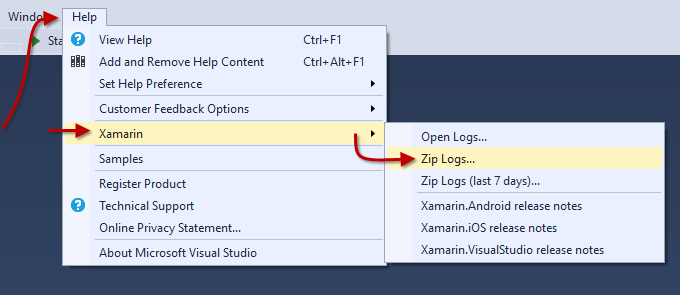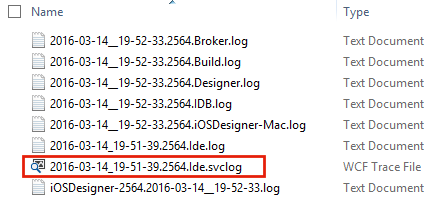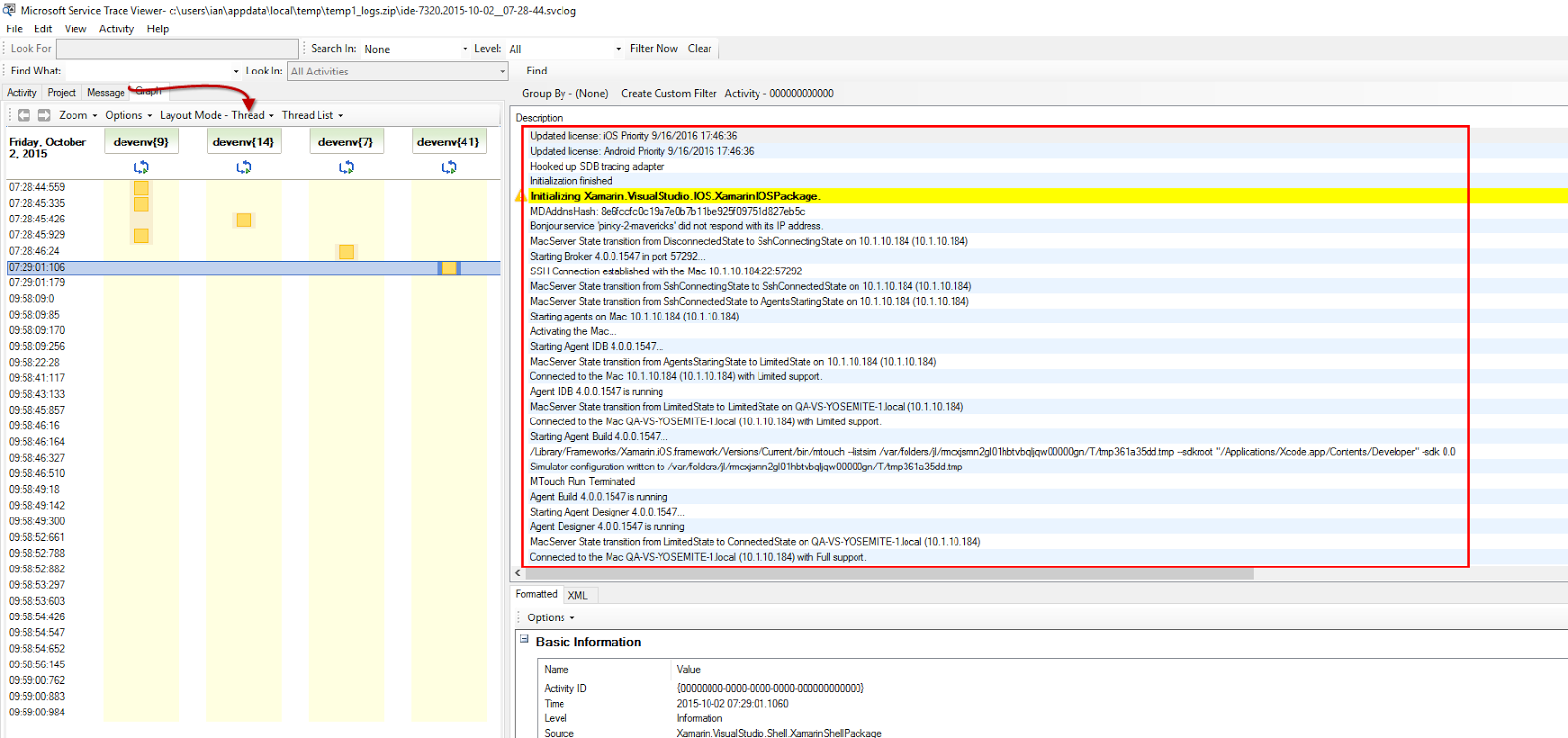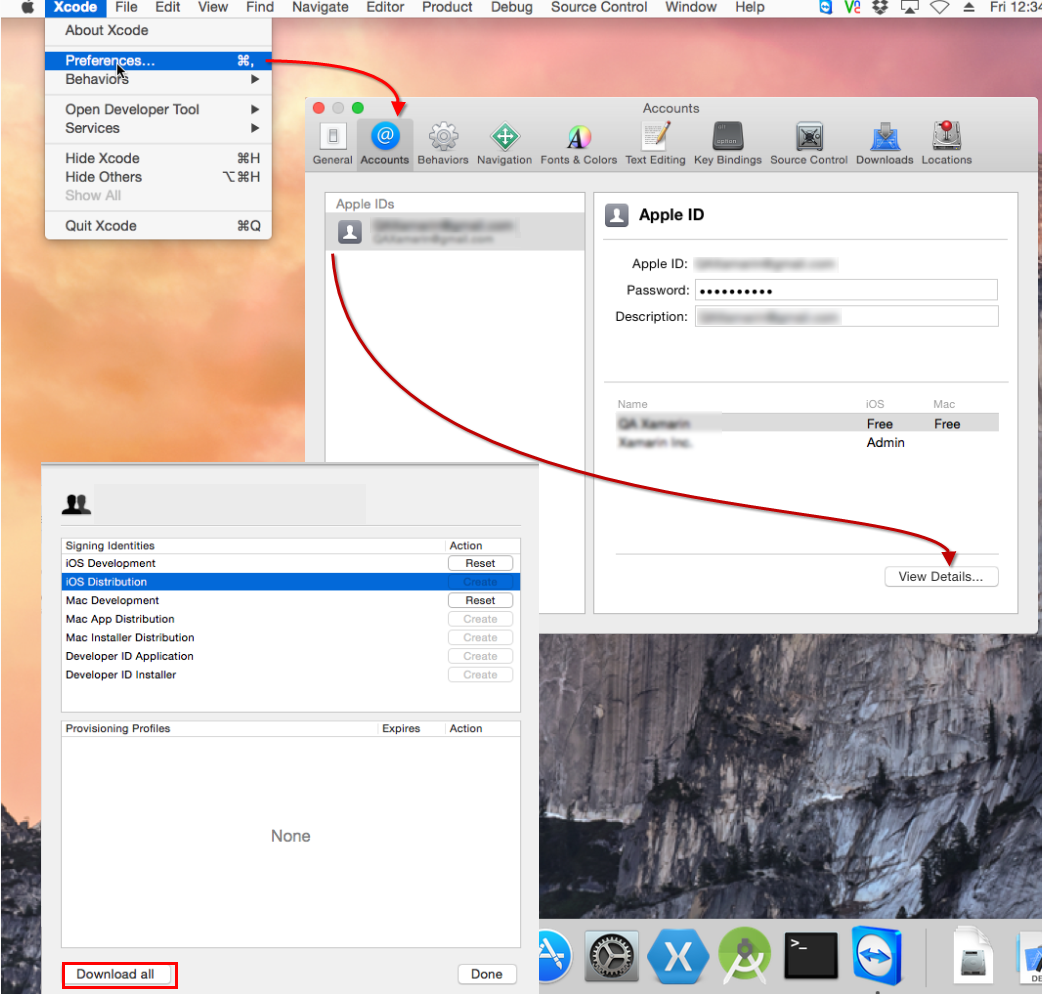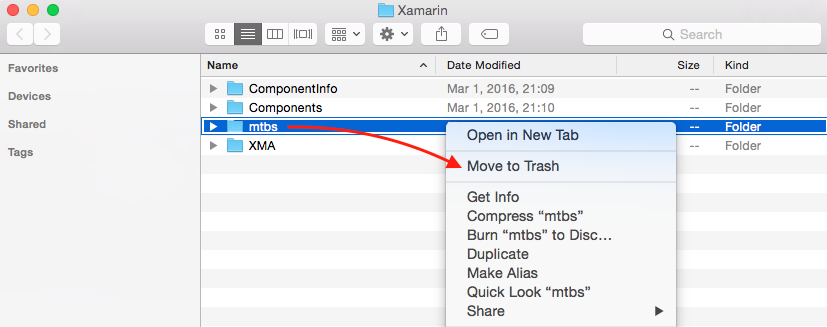Connection Troubleshooting for a Xamarin.iOS Build Host
This guide provides troubleshooting steps for issues that may be encountered using the new connection manager, including connectivity and SSH issues.
Log File Location
- Mac –
~/Library/Logs/Xamarin.Messaging-[VERSION.BUILD] - Windows –
%LOCALAPPDATA%\Xamarin\Logs
The log files can be located by browsing to Help > Xamarin > Zip Logs in Visual Studio.
Where's the Xamarin Build Host App?
The Xamarin Build Host from older versions of Xamarin.iOS is no longer required. Visual Studio now automatically deploys the agent over Remote Login and runs it in the background. There is no additional app that will run on either the Mac or Windows machines.
Troubleshooting Remote Login
Important
These troubleshooting steps are primarily intended for problems that happen during the initial setup on a new system. If you had previously been using the connection successfully in a particular environment and then the connection suddenly or intermittently stops working, you can (in most cases) skip straight to checking if any of the following helps:
- Kill the leftover processes as described below under Errors due to existing Build Host Processes.
- Clear the agents as described under Clearing the Broker, IDB, Build, and Designer Agents, and then use a wired internet connection and connect directly via the IP address as described under Couldn't connect to MacBuildHost.local. Please try again..
If none of those options fix the issue, then please follow the instructions in step 9 to file a new bug report.
Check that you have compatible Xamarin.iOS versions installed on your Mac. To do this with Visual Studio 2017 ensure that you are on the Stable distribution channel in Visual Studio for Mac. In Visual Studio 2015 and earlier make sure that you are on the same distribution channel on both IDEs.
- In Visual Studio for Mac, go to Visual Studio for Mac > Check for Updates... to view or change the Update channel.
- In Visual Studio 2015 and earlier, check the distribution channel under Tools > Options > Xamarin > Other.
Make sure that Remote Login is enabled on the Mac. Set access for Only these users, and make sure your Mac user is included in the list or group:
Check that your firewall allows incoming connections through port 22 - the default for SSH:
If you have disabled Automatically allow signed software to receive incoming connections, OS X will present a dialog during the pairing process asking to allow
mono-sgenormono-sgen32to receive incoming connections. Be sure to click Allow on this dialog:Confirm that you are logged in to the user account on that Mac and have an active GUI session.
Make sure you are connecting to the Mac with the username rather than the Full Name. This avoids a known limitation for full names that include accented characters.
You can find your username by running the
whoamicommand in Terminal.app.For example, from the screenshot below, the account name will be zoed and not Zoe Drakou:
Check that the IP address you are using for the Mac is correct. You can find the IP address under System Preferences > Sharing > Remote Login on the Mac.
Once you have confirmed the IP address of the Mac, try a
pingto that address incmd.exeon Windows:ping 10.1.8.95If the ping fails, then the Mac is not routable from the Windows computer. That problem will need to be solved at the level of the local area network configuration between the 2 computers. Ensure that both machines are on the same Local Network.
Next, test if the
sshclient from OpenSSH can connect successfully to the Mac from Windows. One way to install this program is to install Git for Windows. You can then start a Git Bash command prompt and attempt tosshin to the Mac with your username and IP address:ssh zoed@10.1.8.95If step 8 succeeds, you can try running a simple command like
lsover the connection:ssh zoed@10.1.8.95 'ls'This should list the contents of your home directory on the Mac. If the
lscommand works correctly but the Visual Studio connection still fails, you can check the Known Issues and Limitations section about complications specific to Xamarin. If none of those match your problem, please file a new bug report on Developer Community by going to Help > Send Feedback > Report a problem in Visual Studio and attach the logs described under Check the Verbose Log Files.If step 8 fails, you can run the following command in Terminal on the Mac to see if the SSH server is accepting any connections:
ssh localhostIf step 8 fails but step 10 succeeds, then the problem is most likely that port 22 on the Mac build host is not accessible from Windows due to the network configuration. Possible configuration issues include:
The OS X firewall settings are disallowing the connection. Be sure to double-check step 3.
Occasionally the per-app configuration for the OS X firewall can also end up in an invalid state where the settings shown in System Preferences do not reflect the actual behavior. Deleting the configuration file (/Library/Preferences/com.apple.alf.plist) and rebooting the computer can help restore the default behavior. One way to delete the file is to enter /Library/Preferences under Go > Go to Folder in Finder, and then move the com.apple.alf.plist file to the Trash.
The firewall settings of one of the routers between the Mac and the Windows computer is blocking the connection.
Windows itself is disallowing outbound connections to remote port 22. This would be unusual. It is possible to configure the Windows Firewall to disallow outbound connections, but the default setting is to allow all outbound connections.
The Mac build host is disallowing access to port 22 from all external hosts via a
pfctlrule. This is unlikely unless you know you have configuredpfctlin the past.
If step 8 fails and step 10 fails, then the problem is likely that the SSH server process on the Mac is not running or is not configured to allow the current user to log in. In this case be sure to double-check the Remote Login settings from step 2 before you investigate any more complicated possibilities.
Known Issues and Limitations
Note
This section only applies if you have already connected successfully to the Mac build host with your Mac username and password using the OpenSSH SSH client, as discussed in steps 8 and 9 above.
"Invalid credentials. Please try again."
Known causes:
- Limitation – This error can appear when attempting to log in to the build host using the account Full Name if the name includes an accented character. This is a limitation of the SSH.NET library that Xamarin uses for the SSH connection. Workaround: See step 5 above.
"Unable to authenticate with SSH keys. Please try to log in with credentials first"
Known cause:
- SSH security restriction – This message most often means that one of the files or directories in the fully qualified path of $HOME/.ssh/authorized_keys on the Mac has write permissions enabled for other or group members. Common fix: Run
chmod og-w "$HOME"in a Terminal command prompt on the Mac. For details about which particular file or directory is causing the problem, rungrep sshd /var/log/system.log > "$HOME/Desktop/sshd.log"in Terminal, and then open the sshd.log file from your Desktop and look for "Authentication refused: bad ownership or modes".
"Trying to connect..." never completes
- Bug – This problem can happen on Xamarin 4.1 if the Login shell in the Advanced Options context menu for the Mac user in System Preferences > Users & Groups is set to a value other than /bin/bash. (Starting with Xamarin 4.2, this scenario instead leads to the "Couldn't connect" error message.) Workaround: Change the Login shell back to the original default of /bin/bash.
"Couldn't connect to MacBuildHost.local. Please try again."
Reported causes:
Bug – A few users have seen this error message along with a more detailed error in the log files "An unexpected error occurred while configuring SSH for the user ... Session operation has timed out" when attempting to log in to the build host using an Active Directory or other directory service domain user account. Workaround: Log in to the build host using a local user account instead.
Bug – Some users have seen this error when attempting to connect to the build host by double-clicking the name of the Mac in the connection dialog. Possible workaround: Manually add the Mac using the IP address.
Bug – Some users have run across this error when using a wireless network connection between the Mac build host and Windows. Possible workaround: Move both computers to a wired network connection.
Bug – On Xamarin 4.0, this message will appear anytime the $HOME/.bashrc file on the Mac contains an error. (Starting with Xamarin 4.1, errors in the .bashrc file will no longer affect the connection process.) Workaround: Move the .bashrc file to a backup location (or delete it if you know you don't need it).
Bug – This error can appear if the Login shell in the Advanced Options context menu for the Mac user in System Preferences > Users & Groups is set to a value other than /bin/bash. Workaround: Change the Login shell back to the original default of /bin/bash.
Limitation – This error can appear if the Mac build host is connected to a router that has no access to the internet (or if the Mac is using a DNS server that times out when asked for the reverse-DNS lookup of the Windows computer). Visual Studio will take roughly 30 seconds to retrieve the SSH fingerprint and eventually fail to connect.
Possible workaround: Add "UseDNS no" to the sshd_config file. Be sure to read about this SSH setting before changing it. See for example unix.stackexchange.com/questions/56941/what-is-the-point-of-sshd-usedns-option.
The following steps describe one way to change the setting. You will need to be logged in to an administrator account on the Mac to complete the steps.
Confirm the location of the sshd_config file by running
ls /etc/ssh/sshd_configandls /etc/sshd_configin a Terminal command prompt. For all of the remaining steps, be sure to use the location that does not return "No such file or directory".Run
cp /etc/ssh/sshd_config "$HOME/Desktop/"in Terminal to copy the file to your desktop.Open the file from your Desktop in a text editor. For example you can run
open -a TextEdit "$HOME/Desktop/sshd_config"in Terminal.Add the following line at the bottom of the file:
UseDNS noRemove any lines that say
UseDNS yesto make sure the new setting takes effect.Save the file.
Run
sudo cp "$HOME/Desktop/sshd_config" /etc/ssh/sshd_configin Terminal to copy the edited file back into place. Enter your password if prompted.Disable and re-enable Remote Login under System Preferences > Sharing > Remote Login to restart the SSH server.
Clearing the Broker, IDB, Build, and Designer Agents on the Mac
If your log files show a problem during the "Installing", "Uploading", or "Starting" steps for any of Mac agents, you can try deleting the XMA cache folder to force Visual Studio to re-upload them.
Run the following command in Terminal on the Mac:
open "$HOME/Library/Caches/Xamarin"Control-click the XMA folder and select Move to Trash:
There is a cache on Windows as well that it may help to clear. Open a cmd prompt as Administrator on Windows:
del %localappdata%\Temp\Xamarin\XMA
Warning Messages
This section discusses a few messages that can appear in the Output windows and logs that you can usually ignore.
"There is a mismatch between the installed Xamarin.iOS ... and the local Xamarin.iOS"
As long as you have confirmed that both Mac and Windows are updated to the same Xamarin distribution channel, this warning is ignorable.
"Failed to execute 'ls /usr/bin/mono': ExitStatus=1"
This message is ignorable as long as the Mac is running OS X 10.11 (El Capitan) or newer. This message is not a problem on OS X 10.11 because Xamarin also checks /usr/local/bin/mono, which is the correct expected location for mono on OS X 10.11.
"Bonjour service 'MacBuildHost' did not respond with its IP address."
This message is ignorable unless you notice that the connection dialog does not display the IP address of Mac build host. If the IP address is missing in that dialog, you can still manually add the Mac.
"Invalid user a from 10.1.8.95" and "input_userauth_request: invalid user a [preauth]"
You might notice this messages if you look in the sshd.log. These messages are part of the normal connection process. They appear because Xamarin uses the username a temporarily when retrieving the SSH Fingerprint.
Output Window and Log Files
If Visual Studio hits an error when connecting to the build host, there are 2 locations to check for additional messages: the Output window and the log files.
Output Window
The Output window is the best place to start. It displays messages about the main connection steps and errors. To view the Xamarin messages in the Output window:
- Select View > Output from the menus or click the Output tab.
- Click the Show output from drop-down menu.
- Select Xamarin.
Log Files
If the Output window does not include enough information to diagnose the problem, the log files are the next place to look. The log files contain additional diagnostic messages that do not appear in the Output window. To view the log files:
Start Visual Studio.
Important
Note that .svclogs are not enabled by default. To access them you will need to start Visual Studio with verbose logs as explained in the Version Logs guide. For more information, refer to the Troubleshooting Extensions with the Activity Log blog.
Attempt to connect to the build host.
After Visual Studio hits the connection error, collect the logs from Help > Xamarin > Zip Logs:
When you open the .zip file, you will see a list of files similar to the example below. For connection errors, the most important files are the *Ide.log and *Ide.svclog files. These files contain the same messages in two slightly different formats. The .svclog is XML and is useful if you want to browse through the messages. The .log is plain text and is useful if you want to filter the messages using command line tools.
To browse through all the messages, select and open the .svclog file:
The .svclog file will open in Microsoft Service Trace Viewer. You can browse the messages by thread to see related groups of messages. To browse by thread, first select the Graph tab, then click the Layout Mode drop-down menu and select Thread:
Verbose Log Files
If the normal log files still do not provide sufficient information to diagnose the problem, one last technique to try is to enable verbose logging. The verbose logs are also preferred on bug reports.
Quit Visual Studio.
Start a Developer Command Prompt.
Run the following command in the command prompt to launch Visual Studio with verbose logging:
devenv /logAttempt to connect to the build host from Visual Studio.
After Visual Studio hits the connection error, collect the logs from Help > Xamarin > Zip Logs.
Run the following command in Terminal on the Mac to copy any recent log messages from the SSH server into a file on your Desktop:
grep sshd /var/log/system.log > "$HOME/Desktop/sshd.log"
If these verbose log files do not provide enough clues to resolve the issue directly, please file a new bug report and attach both the .zip file from step 5 and the .log file from step 6.
Troubleshooting automatic Mac provisioning
IDE log files
If you encounter any trouble using automatic Mac provisioning, take a look at the Visual Studio 2017 IDE logs, stored in %LOCALAPPDATA%\Xamarin\Logs\15.0.
Troubleshooting Build and Deployment Errors
This section covers a few problems that can happen after Visual Studio connects successfully to the build host.
"Unable to connect to Address='192.168.1.2:22' with User='macuser'"
Known causes:
Xamarin 4.1 security feature – This error will happen if you downgrade to Xamarin 4.0 after using Xamarin 4.1 or higher. In this case the error will be accompanied by the additional warning "Private key is encrypted but passphrase is empty". This is an intentional change due to a new security feature in Xamarin 4.1. Recommended fix: Delete id_rsa and id_rsa.pub from %LOCALAPPDATA%\Xamarin\MonoTouch, and then reconnect to the Mac build host.
SSH security restriction – When this message is accompanied by the additional warning "Could not authenticate the user using the existing ssh keys", it most often means one of the files or directories in the fully qualified path of $HOME/.ssh/authorized_keys on the Mac has write permissions enabled for other or group members. Common fix: Run
chmod og-w "$HOME"in a Terminal command prompt on the Mac. For details about which particular file or directory is causing the problem, rungrep sshd /var/log/system.log > "$HOME/Desktop/sshd.log"in Terminal, and then open the sshd.log file from your Desktop and look for "Authentication refused: bad ownership or modes".
Solutions cannot be loaded from a Network Share
Solutions will only be compiled if they are on the local Windows file system or a mapped drive.
Solutions that are saved in a network share might throw errors, or completely refuse to compile. Any .sln files used in Visual Studio should be saved on the local Windows file system.
The following error is thrown because of this problem:
error : Building from a network share path is not supported at the moment. Please map a network drive to '\\SharedSources\HelloWorld\HelloWorld' or copy the source to a local directory.
Missing Provisioning Profiles or "Failed to create the a fat library" Error
Launch Xcode on the Mac and ensure that your Apple developer account is logged in and your iOS Development Profile is downloaded:
"A socket operation was attempted to an unreachable network"
Reported causes:
- Enhancement – This error can prevent successful builds when Visual Studio is using an IPv6 address to connect to the build host. (The build host connection does not yet support IPv6 addresses.)
Xamarin.iOS Visual Studio plugin fails to load after reinstallation of beta/alpha channel
This issue may happen when Visual Studio fails to refresh the MEF component cache. If that's the case, installing this Visual Studio extension may help: https://visualstudiogallery.msdn.microsoft.com/22b94661-70c7-4a93-9ca3-8b6dd45f47cd
This will clear the Visual Studio MEF component cache to fix issues with cache corruption.
Errors due to existing Build Host Processes on the Mac
Processes from previous build host connections can sometimes interfere with the behavior of the current active connection. To check for any existing processes, close Visual Studio and then run the following commands in Terminal on the Mac:
ps -A | grep mono
To kill the existing processes use the following command:
killall mono
Clearing the Mac Build Cache
If you are troubleshooting a build problem and want to make sure the behavior is not related to any of temporary build files stored on the Mac, you can delete the build cache folder.
Run the following command in Terminal on the Mac:
open "$HOME/Library/Caches/Xamarin"Control-click the mtbs folder and select Move to Trash:
